MongoDB源碼分析--Command體系架構
Command在Mongodb中是一類特殊操作,它提供了強大的管理及各項操作(比如建庫,索引,刪除集合等)。可以說通過Command可以完成幾乎所有想做的事情。同時Mongodb開發者在Command上又做了非常清晰體系架構和設計,便于管理和高效執行各種類型的Command。
今天就專門用一篇篇幅來著重介紹一下其Command的體系架構,并用例子來介紹mongod是如何將Command引入其中的。
為了對其中大部分command對一個大致的了解,我們可以用下面指令來顯示一個command列表:
- mongod --dbpath d:\mongodb\db --port 27017 --rest
- 在瀏覽器上輸入鏈接地址:http://localhost:28017/_commands
這里mongod就會為我們顯示command列表,大約有90多個,這是顯示截圖:
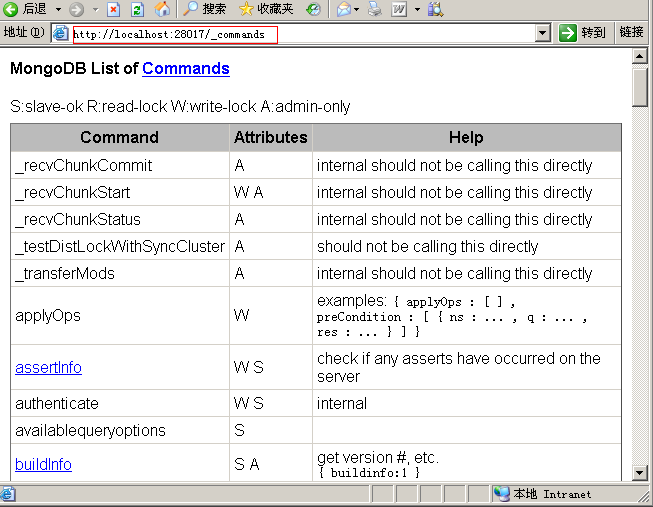
上面90多個類中,按其使用場景可以為分如下幾類,分別是:
- dbcommand.cpp:一般數據庫指令,如數據庫,索引的創建,重建,打開/關閉等
- dbcommands_admin.cpp:管理指令,如CleanCmd,JournalLatencyTestCmd,ValidateCmd,FSyncCommand
- dbcommands_generic.cpp:常用指令,ListCommandsCmd,LogRotateCmd,PingCommand,CmdSet,CmdGet等
- replset_commands.cpp:復制集指令,CmdReplSetTest,CmdReplSetGetStatus,CmdReplSetReconfig等
- security_commands.cpp:安全指令,CmdGetNonce,CmdLogout,CmdAuthenticate
- commands_admin.cpp:shard管理操作,因其位于mongos項目,這里暫不介紹
- commands_public.cpp:shard公用操作,因其位于mongos項目,這里暫不介紹
下面是相關類圖:
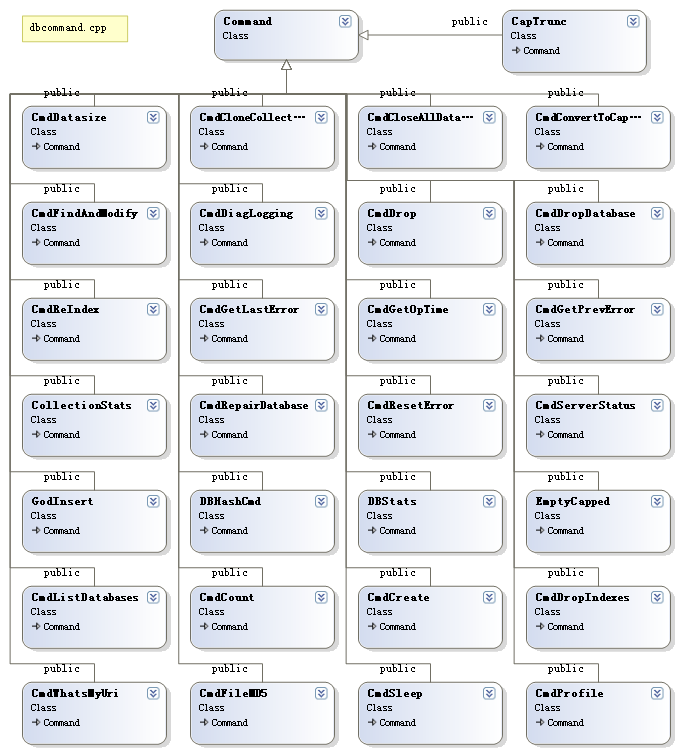
-----------------------------分割線--------------------------------
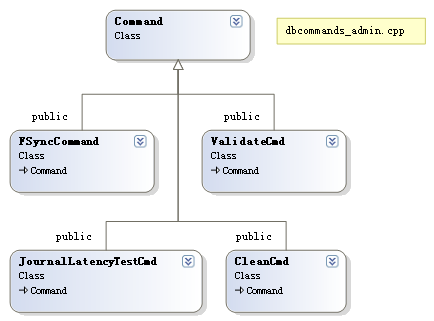
-----------------------------分割線--------------------------------
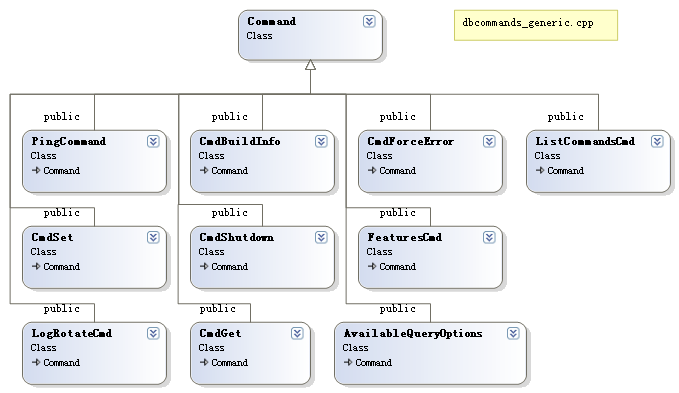
-----------------------------分割線--------------------------------
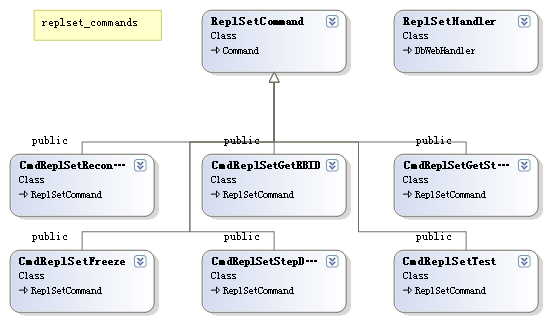
-----------------------------分割線--------------------------------
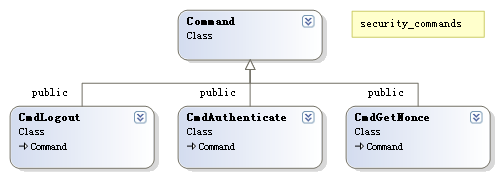
#p#
首先我們看一下在Command的基類,其用于定義子類要實現的方法及屬性,自身也實現了一些通用方法,比如htmlHelp(用于以html方法顯示該command的幫助信息),構造方法,findCommand(查詢命令)等,其聲明如下:
- //commands.h
- class Command {
- public:
- //執行當前Command時所使用的鎖類型
- enum LockType { READ = -1/*讀*/ , NONE = 0 /*無鎖*/, WRITE = 1 /*寫*/};
- const string name;
- /* 運行指定的命令,需要子類實現
- fromRepl - command is being invoked as part of replication syncing. In this situation you
- normally do not want to log the command to the local oplog.
- 如執行成功返回true,否則為false, errmsg記錄錯誤信息
- */
- virtual bool run(const string& db, BSONObj& cmdObj, string& errmsg, BSONObjBuilder& result, bool fromRepl) = 0;
- /*
- note: logTheTop() MUST be false if READ
- if NONE, can't use Client::Context setup
- use with caution
- */
- virtual LockType locktype() const = 0;
- /* 是否有管理特權才可運行該命令 has privileges to run this command. */
- virtual bool adminOnly() const {
- return false;
- }
- //html格式的幫助信息
- void htmlHelp(stringstream&) const;
- /* 與adminOnly相似,但更嚴格: 要么被驗證,要么只運行在本地接口(local interface)
- 注:當本屬性為true時,adminOnly()也必須為true.
- */
- virtual bool localHostOnlyIfNoAuth(const BSONObj& cmdObj) { return false; }
- /* 如果replication pair 的slaves可以運行命令的,則返回true
- (the command directly from a client -- if fromRepl, always allowed).
- */
- virtual bool slaveOk() const = 0;
- /* 通過在查詢命令中打開 'slaveok'選項,客戶端強制在一個slave上運行一個命令時,返回true.
- */
- virtual bool slaveOverrideOk() {
- return false;
- }
- /* Override and return true to if true,log the operation (logOp()) to the replication log.
- (not done if fromRepl of course)
- Note if run() returns false, we do NOT log.
- */
- virtual bool logTheOp() { return false; }
- virtual void help( stringstream& help ) const;
- /* Return true if authentication and security applies to the commands. Some commands
- (e.g., getnonce, authenticate) can be done by anyone even unauthorized.
- */
- virtual bool requiresAuth() { return true; }
- /** @param webUI:在web上暴露當前command,形如 localhost:28017/<name>
- @param oldName: 舊選項,表示當前command的舊(已棄用)名稱
- */
- Command(const char *_name, bool webUI = false, const char *oldName = 0);
- virtual ~Command() {}
- protected:
- BSONObj getQuery( const BSONObj& cmdObj ) {
- if ( cmdObj["query"].type() == Object )
- return cmdObj["query"].embeddedObject();
- if ( cmdObj["q"].type() == Object )
- return cmdObj["q"].embeddedObject();
- return BSONObj();
- }
- static void logIfSlow( const Timer& cmdTimer, const string& msg);
- //command map,其包含系統實現的所有command對象,以便findCommand查詢時使用
- //注意也包含該command的舊名稱(構造方法中的oldName參數)所對應的對象,
- static map<string,Command*> * _commands;
- //與上面形同,但不含舊名稱的command map
- static map<string,Command*> * _commandsByBestName;
- //將web類型的command放到該map中
- static map<string,Command*> * _webCommands;
- public:
- static const map<string,Command*>* commandsByBestName() { return _commandsByBestName; }
- static const map<string,Command*>* webCommands() { return _webCommands; }
- /** @return 返回是否找到或已執行command */
- static bool runAgainstRegistered(const char *ns, BSONObj& jsobj, BSONObjBuilder& anObjBuilder);
- static LockType locktype( const string& name );
- //根據命令名稱在集合中找到相應Command對象
- static Command * findCommand( const string& name );
- };
Command基類中提供了幾個map<string,Command*>類型的集合map,用于將系統實現的Command進行收集,以便后面findCommand進行便歷查詢時使用。如下:
- //commands.cpp
- Command* Command::findCommand( const string& name ) {
- //從_commands map中找到指定name的Command對象
- map<string,Command*>::iterator i = _commands->find( name );
- if ( i == _commands->end() )//如果已到結尾,表示未找到
- return 0;
- return i->second;//返回Command對象
- }
看到上面代碼中的_commands大家可能要問,該map是如何初始化并將系統實現的各個Command注冊到其中呢?答案就在Command的構造方法中,如下:
- //command.cpp
- Command::Command(const char *_name, bool web, const char *oldName) : name(_name) {
- // register ourself.
- //如為空(系統剛啟動時)則實例化_commands
- if ( _commands == 0 )
- _commands = new map<string,Command*>;
- //如為空(系統剛啟動時)則實例化_commandsByBestName
- if( _commandsByBestName == 0 )
- _commandsByBestName = new map<string,Command*>;
- Command*& c = (*_commands)[name];//獲取指定名稱的command對象
- if ( c )//如有,表示之前已注冊了該command
- log() << "warning: 2 commands with name: " << _name << endl;
- //將當前command(this)賦值到map中相應name的command上
- c = this;
- //綁定到_commandsByBestName中的相應name上
- (*_commandsByBestName)[name] = this;
- //如果命令支持web方式
- if( web ) {
- //如為空(系統剛啟動時)則實例化_webCommands
- if( _webCommands == 0 )
- _webCommands = new map<string,Command*>;
- //綁定到_webCommands中的相應name上
- (*_webCommands)[name] = this;
- }
- //如有舊名稱,則也綁到_commands的oldName所指向的command
- if( oldName )
- (*_commands)[oldName] = this;
- }
有了這些還不夠,我們還要從90多個command子類中找出一個來實際分析其實現的方式,這里以最經常使用的count(獲取指定條件的記錄數)來分析其向map中注冊command的流程,參見下面代碼段:
- //dbcommands.cpp
- /* select count(*) */
- class CmdCount : public Command {
- public:
- virtual LockType locktype() const { return READ; }
- //調用基類的構造方法
- CmdCount() : Command("count") { }
- virtual bool logTheOp() {
- return false;
- }
- virtual bool slaveOk() const {
- // ok on --slave setups, not ok for nonmaster of a repl pair (unless override)
- return replSettings.slave == SimpleSlave;
- }
- virtual bool slaveOverrideOk() {
- return true;
- }
- virtual bool adminOnly() const {
- return false;
- }
- virtual void help( stringstream& help ) const { help << "count objects in collection"; }
- virtual bool run(const string& dbname, BSONObj& cmdObj, string& errmsg, BSONObjBuilder& result, bool) {
- string ns = dbname + '.' + cmdObj.firstElement().valuestr();
- string err;
- long long n = runCount(ns.c_str(), cmdObj, err);//執行查詢
- long long nn = n;
- bool ok = true;
- if ( n == -1 ) {
- nn = 0;
- result.appendBool( "missing" , true );
- }
- else if ( n < 0 ) {
- nn = 0;
- ok = false;
- if ( !err.empty() )
- errmsg = err;
- }
- result.append("n", (double) nn);
- return ok;
- }
- } cmdCount;
上面的CmdCount類即是在命令行模式下使用count指令時對應的代碼塊,其自身的構造函數就直接調用了基類(Command)的構造方法。但這里只是定義了還不夠,還需要一個定義類實例代碼(用于啟動構造函數),而這個任務就交給了該類定義的代碼結尾處的下面代碼來實現了:
- } cmdCount;
可以看到,這里使用的是在類聲明后定義對象的方式來執行構造方法(這時并未使用new實例化方式來創建對象指針),進而注冊該command到map。當然繼承自Command的子類必須要實現其中的run()方法,因為只有它是具體command要執行的具體邏輯(可參見上面CmdCount的具體實現)。
到這里只能說mongod在系統啟動到實始化了相應的Command集合map信息,但mongod是如何將client發來的操作請求進行轉換并進而執行相應的command指令的呢?我們接下來繼續分析。
之前看過我的這篇文章的朋友可能還有印象,在mongod啟動之后,會循環偵聽指向端口上的用戶(client)請求,這些請求在mongod中被改裝成了message在各個功能類中傳遞。當用戶發送一個count指令操作時,其會在query.cpp中執行下面方法(以count查詢指令的執行流程為例來進行分析):
- //query.cpp
- const char *runQuery(Message& m, QueryMessage& q, CurOp& curop, Message &result) {
- StringBuilder& ss = curop.debug().str;
- //構造ParsedQuery查詢對象,該對象包括查詢記錄數字,以及記錄跳轉偏移量等信息,
- //這些值會在訪問磁盤查詢時使用,用法參見:query.cpp 662行的virtual void _init()方法
- shared_ptr<ParsedQuery> pq_shared( new ParsedQuery(q) );
- ParsedQuery& pq( *pq_shared );
- ......
- //對查詢命令判斷,指令形如abc.$cmd.findOne( { ismaster:1 } )
- if ( pq.couldBeCommand() ) {//_ns中包括$cmd字符串
- BufBuilder bb;
- bb.skip(sizeof(QueryResult));
- BSONObjBuilder cmdResBuf;
- //對查詢權限判斷,并執行相應查詢指令
- if ( runCommands(ns, jsobj, curop, bb, cmdResBuf, false, queryOptions) ) {
- ss << " command: ";
- jsobj.toString( ss );
- curop.markCommand();
- auto_ptr< QueryResult > qr;
- qr.reset( (QueryResult *) bb.buf() );
- bb.decouple();
- qr->setResultFlagsToOk();
- qr->len = bb.len();
- ss << " reslen:" << bb.len();
- qr->setOperation(opReply);
- qr->cursorId = 0;
- qr->startingFrom = 0;
- qr->nReturned = 1;
- result.setData( qr.release(), true );//設置返回結果
- }
- else {
- uasserted(13530, "bad or malformed command request?");
- }
- return 0;
- }
- .....
- }
上面代碼對傳遞來的查詢消息QueryMessage進行分析之后,如果發現其為command時,執行runCommands方法:
- //query.cpp
- bool runCommands(const char *ns, BSONObj& jsobj, CurOp& curop, BufBuilder &b, BSONObjBuilder& anObjBuilder, bool fromRepl, int queryOptions) {
- try {
- return _runCommands(ns, jsobj, b, anObjBuilder, fromRepl, queryOptions);
- }
- catch ( AssertionException& e ) {
- e.getInfo().append( anObjBuilder , "assertion" , "assertionCode" );
- }
- curop.debug().str << " assertion ";
- anObjBuilder.append("errmsg", "db assertion failure");
- anObjBuilder.append("ok", 0.0);
- BSONObj x = anObjBuilder.done();
- b.appendBuf((void*) x.objdata(), x.objsize());
- return true;
- }
接著其會執行dbcommands.cpp中的_runCommands()方法
- //dbcommands.cpp
- bool _runCommands(const char *ns, BSONObj& _cmdobj, BufBuilder &b, BSONObjBuilder& anObjBuilder, bool fromRepl, int queryOptions) {
- cc().curop()->ensureStarted();
- string dbname = nsToDatabase( ns );
- if( logLevel >= 1 )
- log() << "run command " << ns << ' ' << _cmdobj << endl;
- const char *p = strchr(ns, '.');
- if ( !p ) return false;
- //再次進行cmd判斷,以確定是command
- if ( strcmp(p, ".$cmd") != 0 ) return false;
- BSONObj jsobj;
- {
- BSONElement e = _cmdobj.firstElement();
- if ( e.type() == Object && string("query") == e.fieldName() ) {
- jsobj = e.embeddedObject();
- }
- else {
- jsobj = _cmdobj;
- }
- }
- Client& client = cc();
- bool ok = false;
- BSONElement e = jsobj.firstElement();
- //根據command名稱從map中找出相應的command對象
- Command * c = e.type() ? Command::findCommand( e.fieldName() ) : 0;
- if ( c ) {
- //執行該對象
- ok = execCommand( c , client , queryOptions , ns , jsobj , anObjBuilder , fromRepl );
- }
- else {
- anObjBuilder.append("errmsg", str::stream() << "no such cmd: " << e.fieldName() );
- anObjBuilder.append("bad cmd" , _cmdobj );
- }
- // switch to bool, but wait a bit longer before switching?
- // anObjBuilder.append("ok", ok);
- anObjBuilder.append("ok", ok?1.0:0.0);
- BSONObj x = anObjBuilder.done();
- b.appendBuf((void*) x.objdata(), x.objsize());
- return true;
上面代碼主要是從map中找出相應的command對象,并將該對象及操作命令參數和client(用于獲取其中的認證信息,以確定其執行權限)作為參數,來調用 execCommand方法:
- //dbcommands.cpp
- bool execCommand( Command * c ,
- Client& client , int queryOptions ,
- const char *cmdns, BSONObj& cmdObj ,
- BSONObjBuilder& result /*返回command執行結果*/,
- bool fromRepl ) {
- string dbname = nsToDatabase( cmdns );
- AuthenticationInfo *ai = client.getAuthenticationInfo();
- if( c->adminOnly() /*如果需要有管理特權開可運行*/
- && c->localHostOnlyIfNoAuth( cmdObj ) /*要么被驗證,要么只運行在本地接口*/
- && noauth && !ai->isLocalHost ) {//未認證 且 不是在本地運行
- result.append( "errmsg" ,
- "unauthorized: this command must run from localhost when running db without auth" );
- log() << "command denied: " << cmdObj.toString() << endl;
- return false;
- }
- if ( c->adminOnly() && ! fromRepl && dbname != "admin" ) {
- result.append( "errmsg" , "access denied; use admin db" );
- log() << "command denied: " << cmdObj.toString() << endl;
- return false;
- }
- if ( cmdObj["help"].trueValue() ) {
- stringstream ss;
- ss << "help for: " << c->name << " ";
- c->help( ss );
- result.append( "help" , ss.str() );
- result.append( "lockType" , c->locktype() );
- return true;
- }
- bool canRunHere =
- isMaster( dbname.c_str() ) /*如為master庫*/||
- c->slaveOk() /*如果replication pair 的slaves可以運行命令*/||
- ( c->slaveOverrideOk() && ( queryOptions & QueryOption_SlaveOk ) ) ||
- fromRepl;
- if ( ! canRunHere ) {
- result.append( "errmsg" , "not master" );
- return false;
- }
- if ( c->adminOnly() )
- log( 2 ) << "command: " << cmdObj << endl;
- //如當前command無須鎖時
- if ( c->locktype() == Command::NONE ) {
- // we also trust that this won't crash
- string errmsg;
- //運行當前command
- int ok = c->run( dbname , cmdObj , errmsg , result , fromRepl );
- if ( ! ok )
- result.append( "errmsg" , errmsg );
- return ok;
- }
- //判斷執行當前command是否需要'寫鎖'(每個command子類都有該屬性),枚舉定義如下(command.h):
- //enum LockType { READ = -1/*讀*/ , NONE = 0 /*無鎖*/, WRITE = 1 /*寫*/};
- bool needWriteLock = c->locktype() == Command::WRITE;
- if ( ! needWriteLock ) {
- assert( ! c->logTheOp() );
- }
- mongolock lk( needWriteLock );//聲明鎖對象
- Client::Context ctx( dbname , dbpath , &lk , c->requiresAuth() );
- try {
- string errmsg;
- //運行當前command(本文中提到的count命令)
- if ( ! c->run(dbname, cmdObj, errmsg, result, fromRepl ) ) {
- result.append( "errmsg" , errmsg );
- return false;
- }
- }
- catch ( DBException& e ) {
- stringstream ss;
- ss << "exception: " << e.what();
- result.append( "errmsg" , ss.str() );
- result.append( "code" , e.getCode() );
- return false;
- }
- if ( c->logTheOp() && ! fromRepl ) {
- logOp("c", cmdns, cmdObj);
- }
- return true;
- }
到這里,流程基本就執行完畢了,之后它會將結果傳給result(其傳參為引用類型,即:"& result"方式).
#p#
***用一張時間序來大體回顧一下這***程:
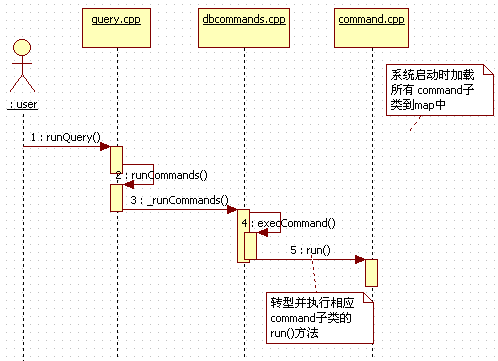
好了,今天的內容到這里就告一段落了。
參考鏈接:
http://www.mongodb.org/display/DOCS/Commands
http://www.10gen.com/reference
原文鏈接:http://www.cnblogs.com/daizhj/archive/2011/04/29/mongos_command_source_code.html
【編輯推薦】
- Mongodb源碼分析--內存文件映射(MMAP)
- 走進MongoDB的世界 展開MongoDB的學習之旅
- 淺析Mongodb源碼之游標Cursor
- 野心勃勃的NoSQL新貴 MongoDB應用實戰
- MongoDB與CouchDB全方位對比





























